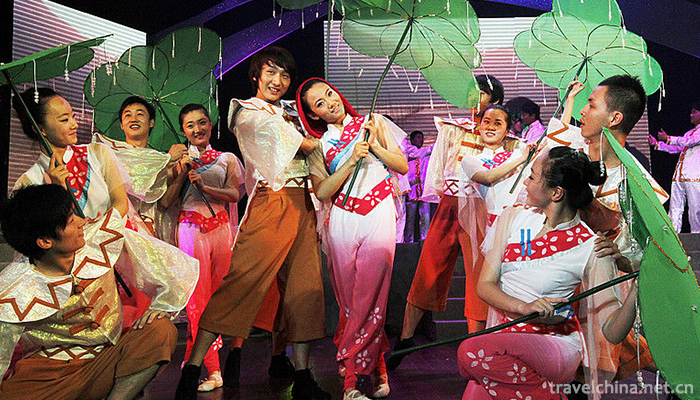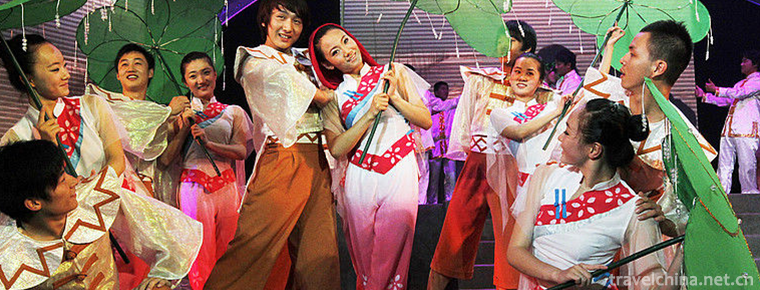Gaoyou folk songs
Gaoyou folk songs
The earliest source of Gaoyou folk songs can be traced back to the Neolithic Age. Gaoyou Lake and Lixia River in Gaoyou City are the traditional folk songs widely spread in their production and life. They mainly include chants, minor tunes, love songs and various kinds of life, custom ballads, nursery songs and antiphonal songs. They have both the soft and graceful characteristics of Southern Jiangsu folk songs and the bright temperament of Northern folk songs, with a gentle and light rhythm. Yu's Lixia River style. Gaoyou folk songs have different characteristics from those of other places. Classic masterpieces: counting duck eggs, Gaoyou northwest township, sending husband to join the army, unloading armour ballads, Yangge chant, my hometown in Gaoyou, returning home
Gaoyou Folk Songs won the Best Urban Songs Award in Shanghai World Expo, the First China Peasant Art Festival, the 12th China Shanghai International Art Festival, the 2nd National Folk Music and Dance Festival in 1957, the 1960 National Congress of Cultural and Artistic Workers, the Spring Festival Gala, the 2nd CCTV Music and Television Exhibition of Seven Image Songs, and the Jianghai Culture and Art Exhibition in China. Zhou, Beijing-Hangzhou Grand Canal (Jiangsu) Arts Festival, CCTV seven sets of local hurdles, CCTV our festival - China Long Song Line series shows, performances and performances.
On October 18, 2007, the Chinese Association of Folk Literators and Artists officially awarded Gaoyou the honorary title of "Hometown of Chinese Folk Songs", which made Gaoyou the only home of Chinese Folk Songs in the country at that time. Compared with other important folk song towns such as Guangxi, Yunnan and Xinjiang, Gaoyou folk song in Lixia River area in central Jiangsu seems to be little known.
On June 7, 2008, Gaoyou Folk Song was approved by the State Council to be included in the second batch of national intangible cultural heritage list.
On June 6, 2010, at the invitation of Jiangsu Organizing Committee of Shanghai World Expo, we participated in the rehearsal of Jiangsu Pavilion Week. The organizing committee has basically decided that the number of duck eggs in Gaoyou Folk Songs will be the weekly exhibition program of Jiangsu Pavilion of the World Expo from June 13 to June 17. Gaoyou Folk Songs shine brilliantly at the Shanghai World Expo.
Historical evolution
Gaoyou Folk Songs were listed as the first intangible cultural heritage list of Jiangsu Province on March 24, 2007, the second national intangible cultural heritage list on June 14, 2008 and the first Yangzhou intangible cultural heritage list on January 17, 2008, and the first group of Gaoyou intangible cultural heritage list on February 8, 2008.
Since the 1980s, Gaoyou has held 31 consecutive competitions and concerts, and has collected and collated 600 Gaoyou folk songs. Gaoyou folk songs have included 272 complete lyrics and songs, with more than 40 tunes.
original ecological folk songs
Hengjing original ecological folk songs are part of Gaoyou folk songs on the national intangible cultural heritage list. It is a famous traditional folk song in Hengjing Town of Gaoyou City. Hengjing original eco-folk song has gained popularity since it was broadcast in 2005 in seven sets of "Gone Songs" by CCTV. Among the original ecological folk songs in Hengjing, a considerable part belongs to love songs. Most of them are arranged in chronological and monthly order, expressing their feelings with song expressions and lyrics, which not only releases feelings, communicates feelings, but also eliminates fatigue and entertains listeners.
historical origin
As early as 7,000 years ago , the ancestors of Gaoyou worked hard, planted rice seedlings, hunted fish and domesticated animals. It can be said that where living people live together, where there is labor, where there are primitive ballads. Therefore, the earliest source of Gaoyou folk songs can be traced back to the Neolithic Age. For thousands of years, Gaoyou folk songs have been handed down orally by the masses and passed down from generation to generation. Many folk songwriters are well known and well-known in China. On October 18, 2007, the Chinese Association of Folk Literary Artists officially awarded Gaoyou the honorary title of "Town of Chinese Folk Songs", which made Gaoyou the only "Town of Chinese Folk Songs" in the country at that time. On June 14, 2008, Gaoyou Folk Songs were listed in the second batch of national intangible cultural heritage list.
According to the textual research, the popular "scattered flower tune" in Gaoyou is one of the sacrificial ballads of the ancient folk "exorcise" in the central Jiangsu area, which is called "countryman exorcise". It has been recorded in the Analects of Confucius and has a history of more than 2000 years. Later, Gaoyou Ci poet Qin Shaoyou and Sanqu master Wang Pan not only drew rich nutrition from folk songs, but also helped to improve the re-creation of folk songs because their lyrics and songs were widely sung. In addition, cultural celebrities such as Pu Songling, who had served as a courier in Gaoyou, directly or indirectly participated in the creation, enriching the connotation of Gaoyou folk songs and enhancing the quality of Gaoyou folk songs. Gaoyou Zhangjiazhuang's seedling-planting slogan "Xiliangyue" (a sad sight of my sister), the lyrics are derived from Feng Menglong's "hanging branches" in the Ming Dynasty. In "Pu Songling's Slang", there are many other songs such as "Reversed Roller" and "Overlapped Bridge" with the same name as the folk songs still popular in Gaoyou. Therefore, Gaoyou and its surrounding areas have also naturally become a fertile soil for folk song creation. In fact, Jiangsu has always been an important "song town" in China, such as "Jasmine Flower" is one of the most influential folk songs in China.
Jiangsu's cultural characteristics are "Wu Yun Han Style", which corresponds to the folk songs of Wu Song in southern Jiangsu and Chu Song in northern Jiangsu. The styles of Wu Song are quite different. The scope of Wu Song includes Su Xichang and Gao Chun in Nanjing, while Suzhou is the "first highland" and its main feature is "ou". The scope of Chu Song is in the northern part of Jiangsu Province, and its style is rugged. Located in the blending zone of Wuge and Chuge, the Lixia River area in Central Jiangsu, with Gaoyou as its center, includes Baoying, Xinghua, Jiangdu, Yizheng, the North-South intersection, and Jianghuai area with Xiajiang Mandarin as its dialect. In the history, the cultural convection between the North and the South, the fresh folk song elements are constantly gathered and supplemented, gradually evolving into an unprecedented prosperous "song village".


-
1.Mount QianQianshan Mountain
Mount Qian,Qianshan Mountain is located 17 kilometers southeast of Anshan City, Liaoning Province, with a total area of 44 square kilometers.
Time 2018-12-04 -
2.Pagoda of Xing Jiao Temple
Hingjiao Temple Pagoda is located in the original Hingjiao Temple of Shaoling, Chang'an District, Xi'an Province, Shaanxi Province. It is a famous figure in the history of Buddhist communication
Time 2018-12-24 -
3.88 Floor Sightseeing Hall of Jinmao Building
Jinmao Tower's 88th floor sightseeing hall, located in Shanghai, China, has a height of 340.1 meters and an area of 1520 square meters. It is the largest sightseeing hall in China at present. It is th
Time 2019-01-26 -
4.qingdao olympic sailing center
Qingdao Olympic Sailing Center Scenic Spot is located in Fushan Bay, Qingdao City, and Qingdao's landmark scenic spot - May 4th Square offshore, covering an area of about 45 hectares
Time 2019-02-07 -
5.Changying Century City
Changying Century City, located in Nanguan District, Changchun City, Jilin Province, was founded in 2003. It is a comprehensive tourist area integrating science and technology, adventure, performing a
Time 2019-03-17 -
6.Sweat green
"Khan Qing Gele" is a heroic epic of the Mongolian people in Haixi. In the form of rap and speech, it tells the story of the Mongolian heroes destroying demons and saving the people, flashin
Time 2019-05-02 -
7.Dark pass
Dark pass Dark Biography, as the first Creation Epic of the Han nationality, is represented by folk songs and songs. It began to circulate in the Ming and Qing Dynasties.
Time 2019-05-03 -
8.The Mausoleum of the Yellow Emperor
The Mausoleum of the Yellow Emperor is one of the national intangible cultural heritages, which has formed a certain scale format and sacrificial ceremonies in the long-term practice.
Time 2019-05-04 -
9.72 Sorcery Music of Lingyun Zhuang Nationality
The 72 witchcraft tunes of Lingyun Zhuang nationality originated in Lingyun County, Guangxi, mainly centered on Sicheng Town, where the county government is located. It is a tune sung by the Zhuang wi
Time 2019-05-13 -
10.temple fair
Temple fair, also known as "temple market" or "festival venue". It is a Chinese folk religion and the custom of the age. It is usually held on the Lunar New Year, the Lantern Festi
Time 2019-06-05 -
11.Bian Que
Bian Que (407 BC - 310 years ago) Ji surname, Qin Shi, name slowly, the word Yue people, also number Lu medicine, the spring and Autumn period and the Warring States period famous doctor. The spring a
Time 2019-09-06 -
12.China Youth University of Political Studies
China Youth University for Political Science (China Youth University of Political Studies) is located in Beijing. It is the state-level "Communist Youth League Central Research Center for the the
Time 2019-12-25